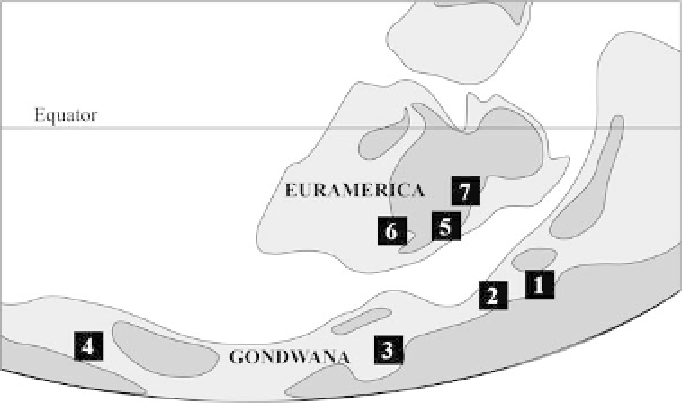Geoscience Reference
In-Depth Information
an earlier appearance in the Cambrian (Wellman
et al. 2003; Steemans & Wellman 2004). Plants
producing more elaborate cryptospores invaded
these areas following the Ordovician glaciation
when the ice sheet that was a barrier to migration
disintegrated.
Numerous cryptospore assemblages are repor-
ted from the Llandovery in Brazil, Paraguay and
Argentina (Fig. 1c). This delay in the colonization
of South America by land plants could be the con-
sequence of the presence of the ice sheet which iso-
lated South America from the rest of the Gondwana.
In addition, as the South American plate moved
towards the north, the northern margin of this part
of Gondwana moved away from the South Pole.
The ice sheet may have disintegrated, opening a
route for a step-by-step colonization by the plants
during the Llandovery. The Iapetus Ocean narrowed
and finally Avalonia-Baltica and Laurentia collided,
leading to the emergence of the Caledonian moun-
tains which formed a palaeogeographic barrier.
Cryptospores then colonized Laurentia, where they
are observed in abundance in Llandovery layers.
The first occurrence of trilete spores (Fig. 2) is
around the Caradoc-Ashgill boundary in Saudi
Arabia (Steemans et al. 2008b; Wellman et al.
2008). Rare trilete spores (Ambitisporites spp.) are
observed in Hirnantian layers from Turkey (Stee-
mans et al. 1996). Ambitisporites is also known
from the early Aeronian in Libya (Richardson
1988), from the upper Aeronian in Paraguay and
Brazil (Le H´riss´ et al. 2001b; Steemans &
Pereira 2002; Mendlowicz Mauller et al. 2004a),
from the youngest Aeronian in the UK (Burgess
1991), from the Aeronian (possibly Telychian) on
the Laurentia plate (Pratt et al. 1978; Strother &
Traverse 1979) and from the Wenlock in Gotland
(Le H´riss´ 1989). This suggests a progressive
colonization by trilete spore-producing plants from
the east to the west. As the Rheic Ocean was narrow-
ing, trilete spore transport by winds from Gondwana
to the Euramerican plate became possible in the
Aeronian. Avalonia is the first to be colonized,
then Laurentia and finally Baltica which is on the
opposite side of the Caledonian mountains.
Phytopalaeogeographic considerations
Comparisons of Lochkovian cryptospore and trilete
spore assemblages between Saudi Arabia and the
UK has led Steemans et al. (2007) to the conclusion:
... that the Old Red Sandstone Continent and Gond-
wana were much closer than postulated in many
palaeocontinental reconstructions, perhaps even
connected, allowing easy migration of cryptospore-
producing plants. Differences in the trilete spore
assemblages from the two continents probably relates
to palaeoenvironmental (climatic) differences and not
to endemism due to palaeogeographical isolation due
to barriers such as a large Rheic Ocean.
The distribution of some biostratigraphically
important trilete spores, that is, Streelispora new-
portensis (Richardson & Lister 1969) and Empha-
nisporites micrornatus var micrornatus (Steemans
& Gerrienne 1984) is also favoured by the palaeo-
geographic reconstruction shown in Figure 1d.
Fig. 2. Schematic Llandovery map showing the first occurrences of the oldest trilete spores according to their
palaeogeographic locations. 1: Caradoc/Ashgill boundary in Saudi Arabia (Steemans et al. 2008b; Wellman et al.
2008); 2: Hirnantian in Turkey (Steemans et al. 1996); 3: Early Aeronian in Libya (Richardson 1988); 4: upper Aeronian
in Paraguay and Brazil (Le H
´
riss
´
et al. 2001b; Steemans & Pereira 2002; Mendlowicz Mauller et al. 2004a); 5:
youngest Aeronian in the UK (Burgess 1991); 6: Aeronian (possibly Telychian) on the Laurentia plate (Pratt et al. 1978;
Strother & Traverse 1979); 7: Wenlock in Gotland (Le H
´
riss
´
1989).

